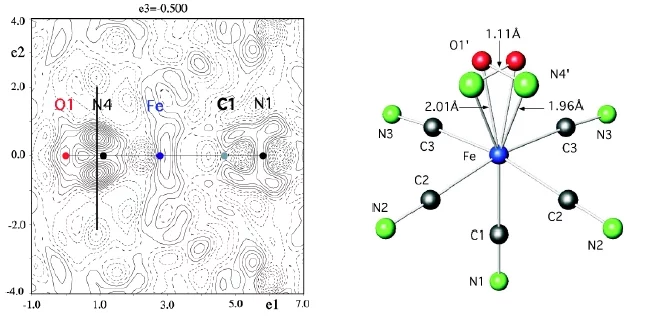Materials for Optical Applications and Nanocrystalline Materials
Project details
New materials are central in the development of new products in our daily life. For example, the continued development of the modern information- and communication-society relies on the ability to store and transmit increasingly larger amounts of data in a fast and secure way as well as nanocrystalline materials. Furthermore and of outmost importance: the physical limits of conventional silicon-based storage and computing systems, as given by the mobility of the electrons, are being approached.
A. Materials for Optical Data Storage
Therefore, holographic data storage and optical computing will be essential in the future development. In contrast to conventional optical devices (e.g. CD, DVD or MOD ) or devices based on magnetic media, which store information in two-dimensional layers, holography gives access to a third dimension: The angular multiplexing of the holograms. Holographic data storage in photorefractive materials was discovered in 1968, one year after the discovery of the photorefractive phenomenon in lithium-niobate. From this starting point a multitude of demonstration platforms have been built, showing the high technological objectives and potential impact of this technology. The main convincing results, beside the proofs of principle, were the achievement of a data density of 40 Gbit/cm2 and a bit-error-rate of less than 1x10-12 retrieved from single crystals of lithium niobate doped with iron. This is superior to the present 7 Gbit/cm2 reached on a commercial DVD. But there are other potential materials beside optical media which may reach a potential for future data storage applications, for example ferroelectric memory devices. On the other hand, optical active materials are of a certain interest in medical applications such as phototherapy.
The LNS group is focused on three aspects: Response of chemical complexes to light induced metastable states [1,2] (we call this materials LIMES), structural deformation/modulations induced by electric fields (electrostriction, for Ref. [3]) and basic properties of ferroelectrics [4].
1) Light-induced metastable states (LIMES): Limes materials such as sodiumnitroprusside are potential materials for optical switches and short-time data storage. On the other hand, it is well known that Nitric-Oxide (NO) plays an important role in biological, biomedical and medical scientific research and applications. It covers a wide range of important biological functions like neurotransmission, enzyme immune- and blood pressure regulation and even inhibition of tumour growth [5,6]. However, with increasing decay temperature of the metastable states, they may become usable as long-term data storage materials.
Our research is therefore following two paths: Theoretical understanding the relatio between the complex structure, the decay temperatures and the maximum population. The goal is to design new materials with optimal parameters. References are given in a recent review [1]. Density functional theory is used to explain physical properties in LIMES systems (such as long life time, light-induced metastable states, e.g.) as well as to predict properties of new material, which might by interesting for goals of the technical applications. The method is able to show tendencies, but up to now failed to predict the diffraction results properly.
A. Materials for Optical Data Storage
Therefore, holographic data storage and optical computing will be essential in the future development. In contrast to conventional optical devices (e.g. CD, DVD or MOD ) or devices based on magnetic media, which store information in two-dimensional layers, holography gives access to a third dimension: The angular multiplexing of the holograms. Holographic data storage in photorefractive materials was discovered in 1968, one year after the discovery of the photorefractive phenomenon in lithium-niobate. From this starting point a multitude of demonstration platforms have been built, showing the high technological objectives and potential impact of this technology. The main convincing results, beside the proofs of principle, were the achievement of a data density of 40 Gbit/cm2 and a bit-error-rate of less than 1x10-12 retrieved from single crystals of lithium niobate doped with iron. This is superior to the present 7 Gbit/cm2 reached on a commercial DVD. But there are other potential materials beside optical media which may reach a potential for future data storage applications, for example ferroelectric memory devices. On the other hand, optical active materials are of a certain interest in medical applications such as phototherapy.
The LNS group is focused on three aspects: Response of chemical complexes to light induced metastable states [1,2] (we call this materials LIMES), structural deformation/modulations induced by electric fields (electrostriction, for Ref. [3]) and basic properties of ferroelectrics [4].
1) Light-induced metastable states (LIMES): Limes materials such as sodiumnitroprusside are potential materials for optical switches and short-time data storage. On the other hand, it is well known that Nitric-Oxide (NO) plays an important role in biological, biomedical and medical scientific research and applications. It covers a wide range of important biological functions like neurotransmission, enzyme immune- and blood pressure regulation and even inhibition of tumour growth [5,6]. However, with increasing decay temperature of the metastable states, they may become usable as long-term data storage materials.
Our research is therefore following two paths: Theoretical understanding the relatio between the complex structure, the decay temperatures and the maximum population. The goal is to design new materials with optimal parameters. References are given in a recent review [1]. Density functional theory is used to explain physical properties in LIMES systems (such as long life time, light-induced metastable states, e.g.) as well as to predict properties of new material, which might by interesting for goals of the technical applications. The method is able to show tendencies, but up to now failed to predict the diffraction results properly.
2) Electrostriction in α-SiO2, GaPO4, KH2PO4 (KDP) and LiNbO3 and LiTaO3:
These materials are widely used as storage media in demonstration platforms for holographic information storage and as wavelength doubling materials in lasers due to the non-linear optical properties. They offer the possibility for holographic recording in the sub-nanosecond-regime resulting in a large data transfer rate. It is known, that pulsed laser illumination leads to the heating-up of the material and thereby to the build-up of pyroelectric fields. Our investigations is focused on the influence of temperature and electric fields on the structure and thereby on the microscopic models. Also here, LNS is focused on structural investigations with neutrons, in a first run on slightly reduced LiNbO3-x compounds.
In KDP, the group at PSI investigates in collaboration with the Universities of Potsdam and Vienna the electrostriction and its atomistic origin and performs structure and strain analysis of lateral nanostructures in such materials.
3) Disordered ferroelectrics, superionics and related materials: These materials have many industrial applications. For instance relaxor ferroelectrics are used in capacitors, actuator systems, opto- and microelectronics; superionic conductors are promising media for use in rechargeable batteries. Due to intrinsic static and dynamic disorder these materials are of interest for fundamental research. Our investigations are focused on the structure [7] and low-frequency dynamics of these materials. In particular, a combination of neutron scattering studies with light scattering spectroscopy was found to be very efficient.
3) Disordered ferroelectrics, superionics and related materials: These materials have many industrial applications. For instance relaxor ferroelectrics are used in capacitors, actuator systems, opto- and microelectronics; superionic conductors are promising media for use in rechargeable batteries. Due to intrinsic static and dynamic disorder these materials are of interest for fundamental research. Our investigations are focused on the structure [7] and low-frequency dynamics of these materials. In particular, a combination of neutron scattering studies with light scattering spectroscopy was found to be very efficient.
- [1] P. Gütlich, Y. Garcia and Th. Woike, Coord. Chem. Rev. 219-221, 839-879 (2001)
- [2] D. Schaniel, J. Schefer, Th. Woike and M. Imlau, Phys. Rev. B (2005) accepted for publication
- [3] O. Audouin, et al, Journal of Selected Topics in Quantum Electronics (JSTQE) (May 2000)
- [4] M.E. Lines and A.M. Glass, “Principles and applications of ferroelectrics and related materials”, Oxford University Press (2001)
- [5] E. Culoota, D. E. Koshland, Science 258, 1862 (1992).
- [6] J. S. Stamler, D. J. Singel, J. Loscalzo, Science 258, 1898 (1992).
Nanocrystalline materials consists of grains with a size in the order of 10 nanometer. In these materials many macroscopic properties are caused by the high density of grain boundaries, whereas in coarse grained materials the lattice properties are dominating.
The determination the local vibrational density of states within the grain boundaries of nanocrystalline metals without a probe is extremely difficult, since although there are about 1000 times more grain boundaries in nanocrystalline materials compared to typical coarse grained material ratio of the number of atoms in the grain boundaries and within the lattice regions is still quite small. Hydrogen is a very suitable probe to investigate the VDOS of nanocrystalline samples, since (I) it is mainly located in the interfaces (grain boundaries or inner surfaces) of nanocrystalline materials, (II) its incoherent cross section of 80 barns is at least one order of magnitude larger than that of other elements. Therefore, the hydrogen enhances the contrast between the interfaces and the grains in neutron scattering experiments.
Since typical metal atoms have about two orders of magnitude more mass than hydrogen atoms, the vibrations of the metal atoms are decoupled from the vibrations of the local vibrations of the H atoms. At frequencies of the acoustic modes of the host metal atoms the interstitial hydrogen follows these vibrations (band modes). Therefore, it is possible to investigate the local vibrational density of states of the metal atoms at the interfaces via the H by inelastic neutron scattering. The separation of the (mainly) coherent scattering of the metal atoms and the (mainly) incoherent scattering of the hydrogen can be done either by neutron spin analysis or by the variation of the H content.
There are also intrinsic changes of many materials properties which are related to the very small grain size when the latter falls below 10 nanometers. These of course will influence poly-nanocrystalline materials as well as powders (where grains are separated). Lattice parameter, melting point, relative stability of polymorphs, surface-related strain fields are examples. Growth methods afford an amazing variety [7] of new shapes and multistructures. Neutron or X-ray diffraction are a very convenient method for investigating structural properties which change with shape, size and structure. Computational methods for the efficient evaluation of diffraction patterns starting from atomic-scale structural models which detail the structure of the whole grain [8,9,10] are being developed with the aim of detecting efficiently and precisely structural variations in nanomaterials.
References
The determination the local vibrational density of states within the grain boundaries of nanocrystalline metals without a probe is extremely difficult, since although there are about 1000 times more grain boundaries in nanocrystalline materials compared to typical coarse grained material ratio of the number of atoms in the grain boundaries and within the lattice regions is still quite small. Hydrogen is a very suitable probe to investigate the VDOS of nanocrystalline samples, since (I) it is mainly located in the interfaces (grain boundaries or inner surfaces) of nanocrystalline materials, (II) its incoherent cross section of 80 barns is at least one order of magnitude larger than that of other elements. Therefore, the hydrogen enhances the contrast between the interfaces and the grains in neutron scattering experiments.
Since typical metal atoms have about two orders of magnitude more mass than hydrogen atoms, the vibrations of the metal atoms are decoupled from the vibrations of the local vibrations of the H atoms. At frequencies of the acoustic modes of the host metal atoms the interstitial hydrogen follows these vibrations (band modes). Therefore, it is possible to investigate the local vibrational density of states of the metal atoms at the interfaces via the H by inelastic neutron scattering. The separation of the (mainly) coherent scattering of the metal atoms and the (mainly) incoherent scattering of the hydrogen can be done either by neutron spin analysis or by the variation of the H content.
There are also intrinsic changes of many materials properties which are related to the very small grain size when the latter falls below 10 nanometers. These of course will influence poly-nanocrystalline materials as well as powders (where grains are separated). Lattice parameter, melting point, relative stability of polymorphs, surface-related strain fields are examples. Growth methods afford an amazing variety [7] of new shapes and multistructures. Neutron or X-ray diffraction are a very convenient method for investigating structural properties which change with shape, size and structure. Computational methods for the efficient evaluation of diffraction patterns starting from atomic-scale structural models which detail the structure of the whole grain [8,9,10] are being developed with the aim of detecting efficiently and precisely structural variations in nanomaterials.
References
- [7] De Giorgi M. et al., Microel. J. 36, 552 (2005)
- [8] A. Cervellino, C. Giannini, A. Guagliardi, J. Appl. Cryst. 36, 1148 (2003)
- [9] A. Cervellino et al., Eur. Phys. J. B 41, 485 (2004)
- [10] A. Cervellino et al., Phys. Rev. B 72, 035412 (2005)
Single photoswitchable molecules of (CN3H6)2[Fe(CN)5NO] (GuNP) are
embedded into nanopores of an SiO2 xerogel (Fig.3). It has been shown that it is possible to
identify the structural motif (‘fingerprint’) of the embedded complex by
analyzing neutron powder diffraction data of DMC@SINQ in a limited Q range (Q < 37 nm-1)
using the Debye approach. The structural study reveals that the pores are
occupied by GuNP monomers with a fill factor of 60–80%. The mutual
arrangement of the anion and cations in the GuNP monomer is slightly changed
while the bond lengths within the anion and cation are almost un changed with respect to the single-crystalline form of GuNP [11]
Reference
Reference
- [11] A. Cervellino, A. Schuy, J. Schefer, L. Keller, Th. Woike and D. Schaniel: Structure of single photoswitchable nitrosyl complexes in nanopores of SiO2 xerogels. J. Appl. Cryst. 43, 1040 (2010)
External researchers
- Prof. Dr. Dominik Schaniel, dominik.schaniel@crm2.uhp-nancy.fr
- Dr. Karl Krämer, karl.kraemer@iac.unibe.ch
- Prof. Dr. Mirco Imlau , mimlau@uni-osnabrueck.de
- PD Dr. Theo Woike, theo.woike@tu-dresden.de
- Prof. Dr. Vaclav Petricek, petricek@fzu.cz
- Prof. Dr. Niels Hansen, hansen@lcm3b.u-nancy.fr
- Antonio Cervellino, Antonio.Cervellino@psi.ch
Funding: SNF, Others
Partners:
Université de Lorraine, Nancy, France, http://www.univ-lorraine.fr/
Universität Bern, Switzerland, http://www.unibe.ch/
Contact: juerg.schefer@psi.ch, Jürg Schefer
Partners:
Université de Lorraine, Nancy, France, http://www.univ-lorraine.fr/
Universität Bern, Switzerland, http://www.unibe.ch/
Contact: juerg.schefer@psi.ch, Jürg Schefer




![Fig. 3: Single photoswitchable molecules of (CN3H6)2[Fe(CN)5NO] (GuNP) embedded into nanopores of an SiO2 xerogel (blue).](/sites/default/files/styles/primer_full_image_xxl/public/import/lns/ResearchProject3EN/xerogel.png.webp?itok=4AqCXwKr)